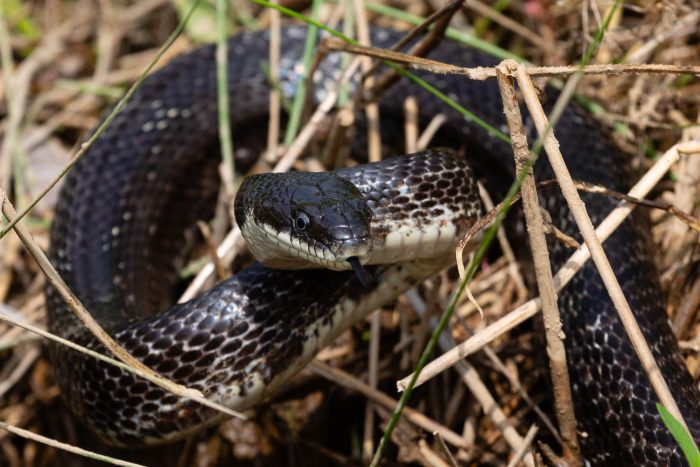Black Rat Snake
Elaphe obsoleta obsoleta
The black rat snake is a non-venomous snake with a long, black body and white belly. It can be found throughout the Chesapeake Bay watershed, from the mountains to the shoreline.
This section shows one large critter image at a time. Use the thumbnails that follow to select a specific image to display here.

This gallery contains a grid of small thumbnails. Selecting a thumbnail will change the main image in the preceding section.
Appearance
The black rat snake grows to three to six feet in length. It has a black, scaly body and a white belly and chin. Young black rat snakes, called hatchlings, are light gray with black blotches along the back.
Feeding
Black rat snakes mostly eat small rodents, such as mice, rats, moles and chipmunks. They are also known to feed on small lizards, frogs and bird eggs.
They kill their prey by constriction, which means the snake coils its body around the prey and holds on until the prey suffocates to death. It then swallows its prey whole and digests it slowly, over the course of several days.
Predators
The black rat snake’s most common predators include foxes, hawks and owls. It protects itself from predators by coiling its body and vibrating its tail in dead leaves, imitating the sound of a rattle. If they are picked up or handled, they may also release a foul-smelling musk to deter predators from eating it. Among the many species of rat snakes, black rat snakes are known to be the most combative when threatened.
Reproduction and life cycle
These snakes emerge from hibernation in March through May and seek out a mate in late April to early June. Females typically reach sexual maturity at around four years old. Males use pheromones to initiate mating with females that pass through their territory. Five weeks after mating, females lay 12 to 20 eggs in a hidden area, such as under leaves or within a hollow log.
Eggs hatch 65 to 70 days later. Females may lay two egg clutches per year, if conditions are right. Black rat snakes typically live 10 to 15 years in the wild; however, these snakes have been known to live over 30 years in captivity.
Did you know?
- Black rat snakes are one of the most common snakes found in suburban backyards around the Chesapeake Bay watershed.
- Like most species of snakes, black rat snakes are not social creatures and prefer to live and hunt alone.
- These snakes are excellent climbers that are able to scale brick walls and tree trunks without any aid.
- Shy and secretive, black rat snakes usually avoid confrontation.
- Although they may strike if they feel threatened, black rat snakes are not venomous.
- Farmers often appreciate having black rat snakes around, as they will eat rats, mice and other pests.
Sources and additional information
- Animal Diversity Web: Pantherophis obsoletus – University of Michigan Museum of Zoology
- Rat Snake (Elaphe obsoleta) – Savannah River Ecology Laboratory
